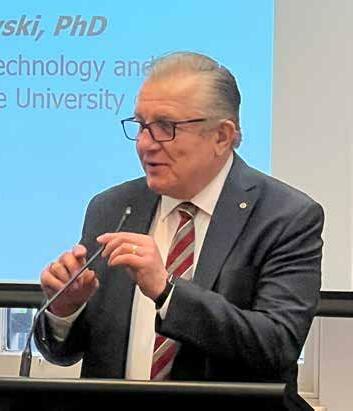
3 minute read
October Monthly Luncheon with Professor Milé Terziovski
October Monthly Luncheon
Advertisement
Post-covid Wake-up call for Small and Medium Enterprises (SMEs) to adopt Digital Innovation
Professor Milé Terziovski, PhD is the Department Chair, Business Technology and Entrepreneurship, at Swinburne University of Technology. Milé began by outlining the four objectives of his presentation. They are: • Digital technologies during COVID-19 - the challenges faced and the opportunities for SMEs. • Latest Productivity Commission report - on
Australia’s global innovation performance. • Preliminary findings - two focus group discussions with SMEs during the pandemic. • And Implications for SMEs - post-pandemic innovation ecosystem.
Here are some salient points taken from Professor Terziovski‘s presentation.
Covid-19 is indeed a wake-up call for companies and has certainly changed the way digital technology strategy is viewed. As Mohit Joshi, President of Healthcare and Life Sciences, Infosys Ltd, in a World Economic Forum article commented, “the pandemic is the ultimate tipping point for the 21st century. Few industries will avoid being either reformed, restructured or removed. Agility, scalability, and automation will be watchwords for this new era of business, and those that have these capabilities...will be the winners.”. In a recent report, titled “5-year Productivity Inquiry: innovation for the 98% - interim report”, published by Productivity Commission, diffusion of international bWest practice has slowed and only 2% of Australian businesses are global innovators, Australian Financial Review (AFR), 27 September 2022. Productivity Commission Deputy Chairman, Dr Alex Robson was quoted in the AFR that there were likely to be bigger economic gains from encouraging “everyday, incremental innovation” than trying to make Australian businesses world leaders. In the latest report on Global Innovators, the shift focus to 98%: a. adopt established technologies and practices. b. develop manager’s ability to exploit innovation. c. expand employer-nominated migration program. d. leveraging the innovation ecosystem: – industry bodies – to learn new and better ways of operating. – stronger linkages with universities beyond direct commercialisation. – assessment of business performance - major motivator and path to improvement
Focus Group Findings
SMEs have limited resources as our focus group discussion revealed, and these enterprises were dependent on large companies to shape the innovation ecosystem by engaging with new innovations, incubating start-ups and providing trained workers. SMEs recognise that digital technologies are seen as enablers of productivity improvement but lack digital strategies on how to develop new business models for post-pandemic business continuity. Cloud computing was adopted by some SMEs who felt safer to get through the pandemic and they recognise the urgent need to implement cyber security systems.
Professor Milé Terziovski
SMEs recognise the need to build innovation capability through digital transformation to transform their existing business models and to upskill, reskill, and train their workforce for the post-pandemic future. Digital Transformation is not about technology alone but also about: – people – implementation and change management. – process – business decisions, measurement, feedback loops. – data – security, reliability, quality, integration, management. – technology – execution capability, analytic and reporting tools, data management process.
Implications for SMEs
SMEs have an opportunity to make greater use of digital technologies to transform their business processes, and empowering their employees to work in new ways, including reskilling, upskilling, cross-sector digital collaborating and implementing cybersecurity systems urgently.
According to Chief Security Officer (CSO) at Interactive, “the global cybersecurity threat is spreading to small to medium enterprises that are unprepared for cybercrime, putting clients, organisational viability at risk.” So preventions in place can include: – educating staff on the importance of cybersecurity. – using two - factor authentication. – applying patches - released by vendors promptly. – restricting access to data - only to people that need it. – Encrypting data – which is of no value to outsiders. – Physical security – preventing physical access to data.
In conclusion
COVID-19 is a wake-up call for SMEs to develop a digital innovation strategy to ensure business continuity by implementing digital transformation (people, process, data, technology). Digital technologies have emerged as key enablers for SMEs, as the world emerges from the Covid-19 pandemic.Cloud computing, automation, artificial intelligence and cybersecurity systems would help SMEs to develop resilience and agility to ensure business continuity.
Thank you Professor Terziovski, for the interesting talk! We are so grateful for your time and effort to reschedule (twice!) during the pandemic!











